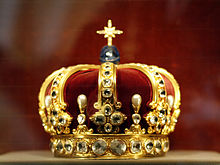Prussian crown jewels
The Prussian Crown Jewels are a collection of regalia of royal power, which were initially used as crown jewels of the Kingdom of Prussia and were also used in the German Empire . In contrast to the often richly adorned and lavishly furnished crown jewels of other monarchs, the insignia of the Hohenzollern were always considered to be rather Spartan.
description
The crown jewels include, among others:
- The royal crown of Frederick I from 1701. It was made in Königsberg for the coronation of the Brandenburg elector and Prussian duke as king in Prussia , as were the following pieces. The crown has practically no jewelery anymore, as the jewels were only attached on special occasions so that they could be used elsewhere at other times. Parts of the jewels were later used in the crown of Wilhelm II (see above). Johann von Besser described the crown around 1712 as follows:
- “ The crown was like the scepter of pure gold / but not / as usual / with foliage = Wercke; but of all diamonds closely attached to one another: on the closed temples and the entire circumference / as if cast from one piece / and not otherwise / then seemed to be divided by the difference in size; because some of them were eighty / ninety and one hundred grains / yes, some diamonds even one hundred and thirty / held in weight / and subsequently fell into the face with different fire. "
- The crown of Wilhelm II , or Hohenzollern crown , which was made in 1889 for the (never took place) coronation of Wilhelm as King of Prussia . This is not an imperial crown, although the German Empire had had one since 1875 in the model for Kaiser Wilhelm I made of silver and rhinestones (as well as a model of the crown of Empress Augusta from 1877), but actual crowns were never made for the Imperial couple made. The last Prussian royal crown mentioned above contains, among other things, a large sapphire , a diamond-adorned golden cross, 142 diamonds , 18 large brilliant-cut diamonds and eight large pearls . The crown has eight stirrups.
- The scepter of Frederick I, also from 1701. For this object, an existing golden scepter was enriched with a Prussian eagle and various other parts.
- The imperial orb of Frederick I.
- The imperial seal of Frederick I
- The imperial sword of Frederick I
- The queen's crown , also a piece made especially for the coronation ceremony of 1701.
- The original electoral hat of the Electorate of Brandenburg and another Brandenburg electoral hat of the Great Elector with four beaded temples.
- The scepter of the Electorate of Brandenburg, the Kurbrandenburg command staff and the Brandenburg Kurschwert.
- The carcasses (metal frames) of the crowns of Wilhelm I and Queen Augusta from 1861.
history
After the abdication of the Hohenzollern family, the majority of the crown jewels passed into the family's possession in 1927 and were initially exhibited in the Monbijou Palace in Berlin . During the Second World War , they were first relocated to Königsberg in 1944, but then brought to the Bernterode mine in Thuringia , from where the American occupation forces transported them with other found cultural goods to Hesse and finally returned them to the family. The last Prussian royal crown (Wilhelm II) was immured in a wall of the crypt of the Westphalian village church of Kleinenbremen near Minden under circumstances that are still mysterious today at the instigation of Kurt von Plettenberg , head of the general administration of the formerly ruling Prussian royal family . It was also later returned to the Hohenzollern by the British military. Most of the surviving pieces are now on display in Charlottenburg Palace in Berlin, only the crown of Wilhelm II can be viewed at Hohenzollern Castle . The crown carcasses made for King Wilhelm I and Queen Augusta on the occasion of the coronation and hereditary homage in Königsberg in 1861 from the crown treasure of the Hohenzollern in the former Monbijou Palace in Berlin have been lost to this day, as have the famous wedding crown of the Prussian princesses and the above-mentioned models of the imperial and empress crown.
literature
- Susanne Evers, Michaela Völkel: Crown Treasure and Silver Chamber of the Hohenzollern , ed. from the Prussian Palaces and Gardens Foundation Berlin-Brandenburg . Deutscher Kunstverlag , Berlin 2010, ISBN 978-3422070509 .





